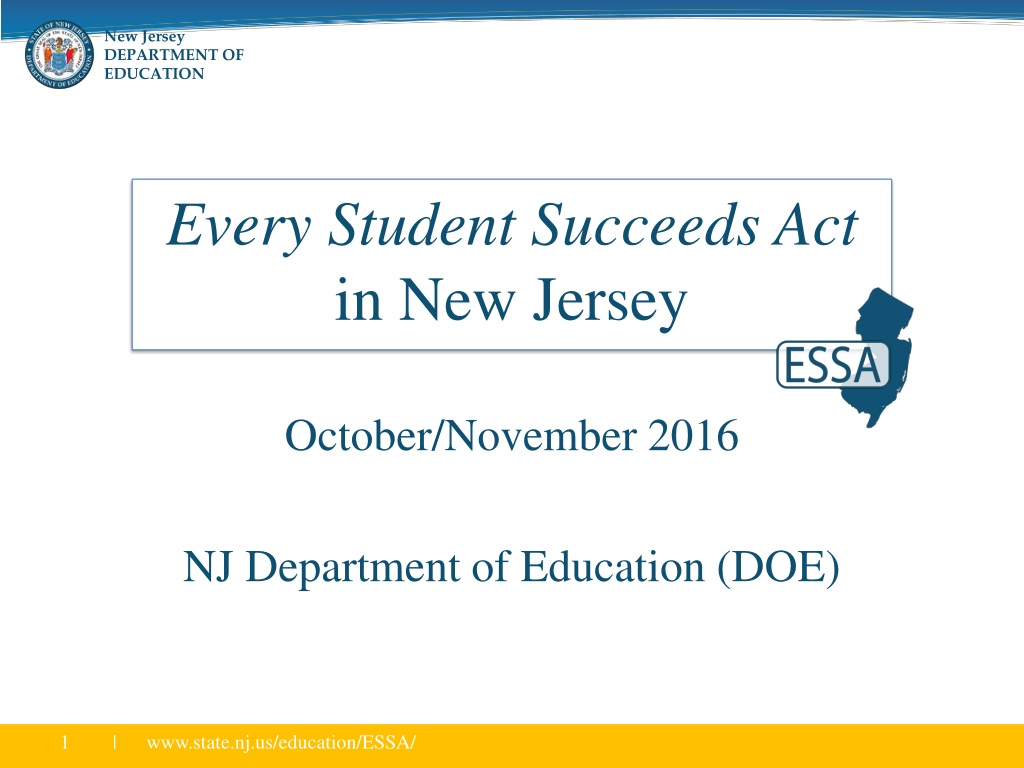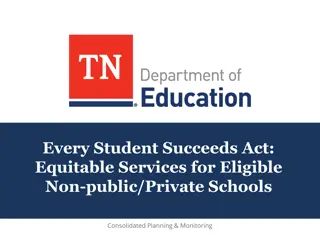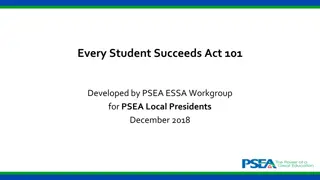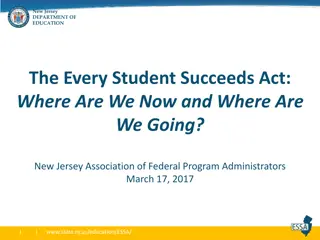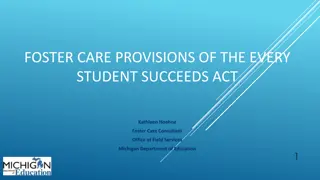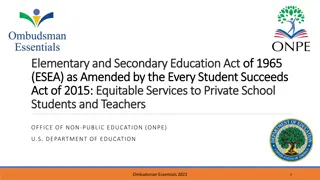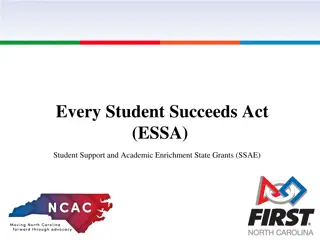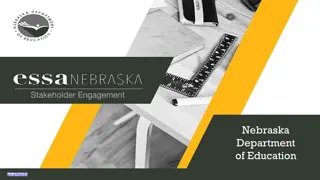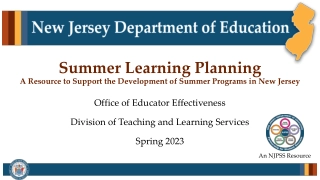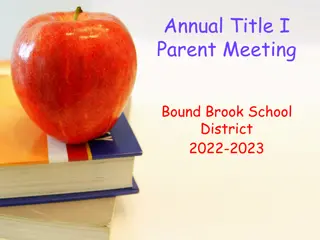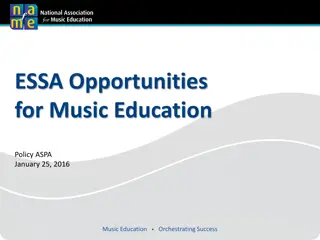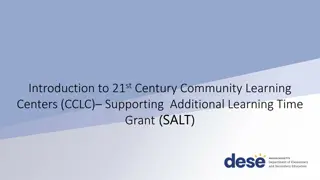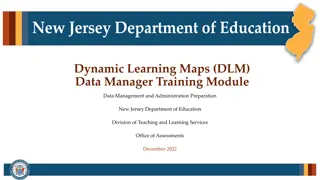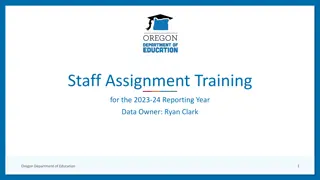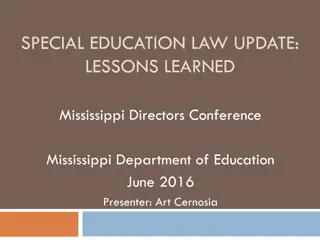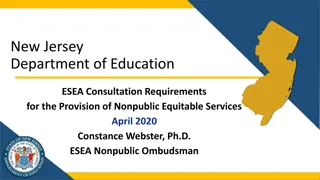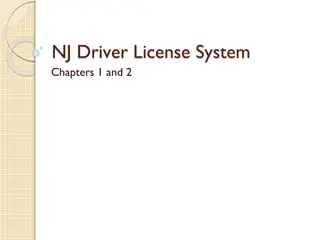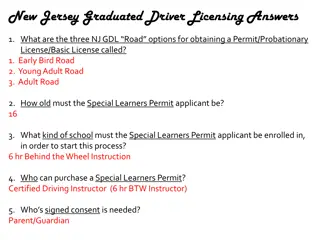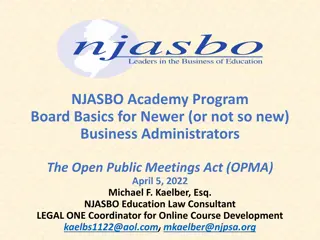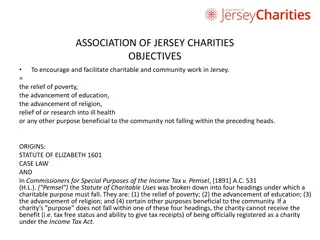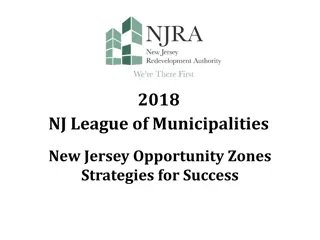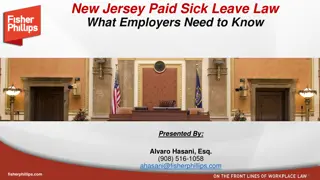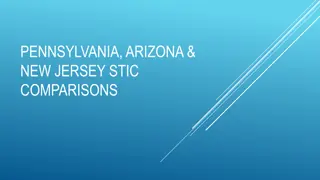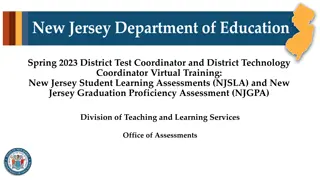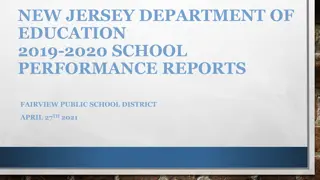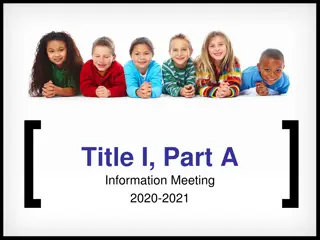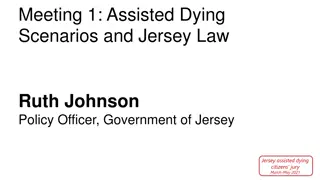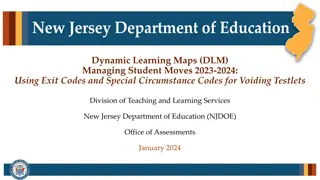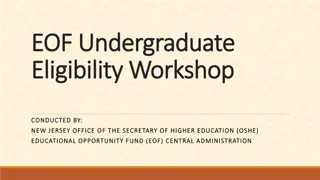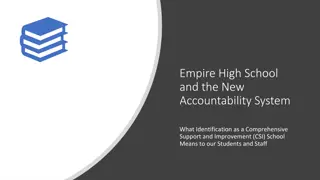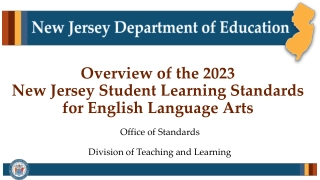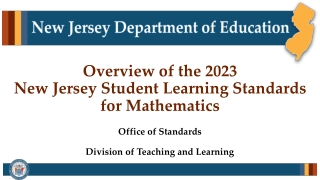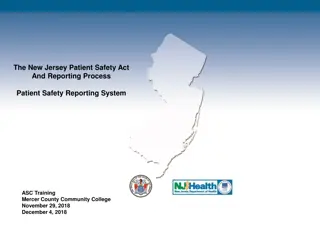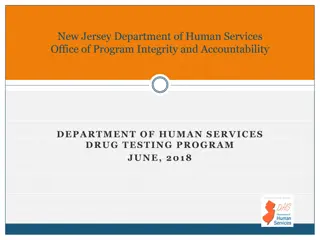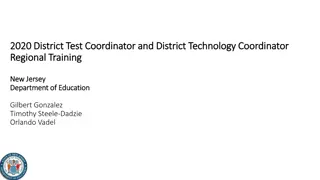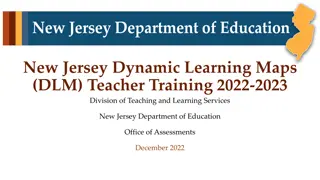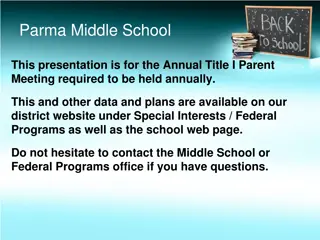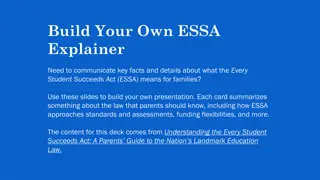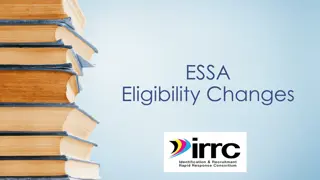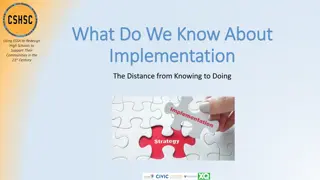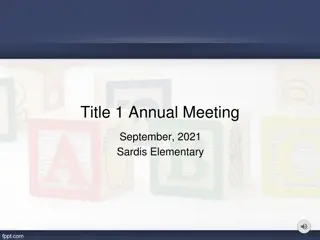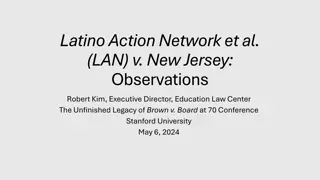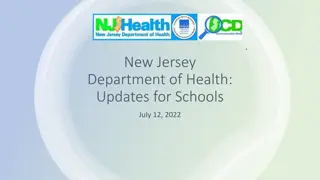New Jersey Department of Education - Every Student Succeeds Act Overview
The Every Student Succeeds Act (ESSA) reauthorizes the Elementary and Secondary Education Act to ensure equitable access to educational resources. New Jersey Department of Education (NJDOE) outlines the state's ESSA plan, including funding criteria, application processes, and key focus areas such as law review, state plan development, and support for districts. The timeline details federal reviews, state plan releases, stakeholder feedback sessions, and district support initiatives. NJDOE's ESSA State Plan emphasizes setting goals, measuring progress, and supporting student success through adherence to the NJ Student Learning Standards.
Download Presentation

Please find below an Image/Link to download the presentation.
The content on the website is provided AS IS for your information and personal use only. It may not be sold, licensed, or shared on other websites without obtaining consent from the author. Download presentation by click this link. If you encounter any issues during the download, it is possible that the publisher has removed the file from their server.
E N D
Presentation Transcript
New Jersey DEPARTMENT OF EDUCATION Every Student Succeeds Act in New Jersey October/November 2016 NJ Department of Education (DOE) 1 | www.state.nj.us/education/ESSA/
New Jersey DEPARTMENT OF EDUCATION The Every Student Succeeds Act (ESSA) The Every Student Succeeds Act (ESSA) reauthorizes the Elementary and Secondary Education Act (ESEA), which, when passed in 1965, committed new federal funding to help ensure equitable access to educational resources and opportunities States and districts are eligible for funds if they comply with the specific requirements outlined in the law: Funding is weighted to go to districts with students from low income families Most funds funnel through the state and go directly to schools and districts Federal funds make up only a small percentage of a district s budget (typically, less than 10%) To qualify for funding under the law: Every several years, each state must apply to the U.S. Department of Education Every year, each school district must apply to the State See our video overview a: http://www.state.nj.us/education/ESSA/ 2 | www.state.nj.us/education/ESSA/
New Jersey DEPARTMENT OF EDUCATION NJDOE Internal ESSA Work: 4 Areas of Focus Review of Law, Regulations, and Guidance State Plan Development NJDOE ESSA Work Guidance and Support for LEAs Internal Operational Changes 3 | www.state.nj.us/education/ESSA/
New Jersey DEPARTMENT OF EDUCATION Timeline 2016-17 Oct. Nov. Dec. Jan. Feb. Mar. Apr. May Jun. Jul. Aug. Federal US Department of Education Reviews and Approves State Plans Final Regulations Released Technical State Plan Release State Plan Goes Into Effect State Plan NJDOE Releases Initial Summary of State Plan and Feedback So Far NJDOE Submits Plan to US Dept. of Education Pending Final Regulations Stakeholder Feedback on State Plan Stakeholder Roundtables and Focus Groups Ongoing Stakeholder/NJDOE Collaboration for District ESSA Spending Guidance District Support ESSA District Spending Rules Go Into Effect NJDOE Technical Assistance Sessions Districts Receive from NJDOE Federal Allocations and Apply for Grants 4 | www.state.nj.us/education/ESSA/
New Jersey DEPARTMENT OF EDUCATION ESSA State Plan The New Jersey Department of Education (NJDOE) must submit a plan describing New Jersey s strategy for how it will implement ESSA s requirements and support the success of all students by: Setting long-term goals for schools and students Measuring and reporting how all students are progressing toward achieving the NJ Student Learning Standards and leaving high school prepared for college and career Identifying schools and districts in need of additional support and differentiating support to those schools and districts based on their needs Determining how state-level funds will be used to further support New Jersey students and educators 5 | www.state.nj.us/education/ESSA/
New Jersey DEPARTMENT OF EDUCATION ESSA Overview Developing the ESSA State Plan ESSA offers an opportunity to expand how New Jersey defines a high-quality education and to emphasize and reward additional qualities that make for a successful school Parents and Students ESSA NEW JERSEY STATE PLAN Professional Organizations Some elements include: How the state measures and reports on school performance What factors make a successful school? How the state helps struggling schools better meet the needs of students How the state prioritizes federal funds Teachers & School Leaders Community Groups 2017-18 NJ State Plan to Implement ESSA 6 | www.state.nj.us/education/ESSA/
New Jersey DEPARTMENT OF EDUCATION Commitment to Ongoing Engagement 2016 2017 Jun Jul Aug Sept Oct Nov Dec Jan Feb Mar Apr May Jun Listening and Learning/Identify Policy Questions Feedback on Specific Proposals/Policies Inform and Explain Implementation Details NJDOE will provide opportunities for stakeholders to: Discuss how NJ state and districts may best implement specific areas of existing and new federal law Provide targeted feedback, through focus groups and public comment Receive updated information about ESSA implementation and best practices 7 | www.state.nj.us/education/ESSA/
New Jersey DEPARTMENT OF EDUCATION Engagement So Far Received over 5,000 survey responses from members of school communities in every county about what type of public school information should be publicly reported Attended or hosted over 50 meetings with representatives from a variety of organizations Hosted four Listening and Learning Sessions throughout the state where we met with over 140 attendees and heard from 35 speakers who represented or were members of 26 different organizations and/or communities 8 | www.state.nj.us/education/ESSA/
New Jersey DEPARTMENT OF EDUCATION Now and Moving Forward In response to stakeholder feedback, the NJDOE has invited over 80 community and educator groups to send a representative to an ESSA Stakeholder Focus Group, which will meet periodically over the next few months to provide input on policy questions related to the state plan Attending or hosting community and practitioner roundtable meetings throughout state Compiling comments, questions and concerns to ensure internal decision makers have the relevant information and the public sees the input we receive 9 | www.state.nj.us/education/ESSA/
New Jersey DEPARTMENT OF EDUCATION Challenging Academic Standards Must adopt: o Academic standards for math, reading or language arts, and science: must be aligned with entrance requirements for credit-bearing coursework at state higher education institutions and with relevant state career and technical education standards. o English language proficiency standards: must be derived from four domains (speaking, listening, reading and writing), address the different proficiency levels of English learners, and be aligned with the challenging state academic standards. May adopt: o Alternate academic achievement standards for students with the most significant disabilities. 10 | www.state.nj.us/education/ESSA/
New Jersey DEPARTMENT OF EDUCATION Academic Assessments Title I, Part A, Section 1111(b)(2), Academic Assessments NCLB 1111(b)(3) ESSA 1111(b)(2) All students in required grades State must ensure at least 95% of all students and each subgroup in each school take the assessment All students in required grades State must ensure at least 95% of all students and each subgroup in each school take the assessment Who must take statewide assessments? Math and English Language Arts (ELA): Each of grades 3-8; and Once in grades 10-12 Math and English Language Arts (ELA): Each of grades 3-8; and Once in grades 9-12 In which grades must students take statewide assessments? Science: Once in grades 3-5; Once in grades 6-9; and Once in grades 10-12 Science: Once in grades 3-5; Once in grades 6-9; and Once in grades 10-12 11 | www.state.nj.us/education/ESSA/
New Jersey DEPARTMENT OF EDUCATION Accountability & Reporting: How are Measures Used? Indicators and data points are chosen in order to understand: How schools and their students are performing in New Jersey? But different measures are used differently in the system: ESSA Accountability INDICATORS Performance Report DATA e.g. Academic Performance & Progress e.g. Post-Secondary College Enrollment USED TO: USED TO: 1. Help families, communities, and schools better understand how students and schools are performing 2. Help leaders (parent, community, school) to make more informed decisions about how to support students 1. Identify schools in need of targeted or comprehensive support and improvement and the lowest performing schools under ESSA, and allocate Title I funds accordingly 12 | www.state.nj.us/education/ESSA/
New Jersey DEPARTMENT OF EDUCATION Indicators of School and Student Success What are the Required Indicators for Accountability? Elementary and Middle School Indicators Academic Achievement (Proficiency) Academic Progress All indicators must: be supported by research that performance and/or progress are likely to increase allow for meaningful differentiation of schools (i.e. help to determine which may need support) High School Indicators Academic Achievement (may also include progress) 4-year Graduation Rate (may include extended-year) All School Indicators Progress Toward English Language Proficiency (may also include proficiency rates) At Least One ADDITIONAL Indicator of School Quality or Student Success 13 | www.state.nj.us/education/ESSA/ ESEA: 1111(c)(4)(B), Proposed: 34 CFR 200.14
New Jersey DEPARTMENT OF EDUCATION Annual Meaningful Differentiation of Schools Starting in 2017-18 (except chronically underperforming 2018-19), school and district performance on all indicators will be used to: Identify schools in need of support and improvement: the lowest 5% of all Title I schools and any public high schools with graduation rates less than 67% for Comprehensive Support and Improvement; and the schools for Targeted Support and Improvement in which a subgroup, on its own, performs at the same level as the lowest 5% of schools; Identify school and district performance across the state high and low performing schools. What type of school/district supports are most helpful once schools in need of support and improvement are identified? 14 | www.state.nj.us/education/ESSA/
New Jersey DEPARTMENT OF EDUCATION Performance Report: Required Measures Academic Measures Quality, Climate, Safety Measures Academic proficiency and growth on statewide tests, including how each school performed compared to other schools in the district and state Graduation rates Enrollment in pre-school, advanced coursework (was optional under NCLB) and post-secondary programs Results on NAEP, if applicable (federal exam for select group of 4th and 8th graders nationwide) Rates of: In-school and out-of-school suspensions Expulsions School-related arrests Law enforcement referrals Chronic absenteeism Violence incidents (bullying and harassment included) Equity Measures English Language Proficiency Measures Per-pupil expenditures of funds by school Disaggregated by high-poverty compared to low- poverty schools, the number and percentage of: Inexperienced teachers, principals, and other school leaders Teachers with an emergency or provisional certificate Teachers who are not teaching in the subject or field for which they are certified (last three bullets formerly reported as HQT) Ineffective educators, as defined by the state The number and percentage of English learners attaining English language proficiency each year The progress of English learners toward achieving the state's goals for achieving English proficiency These were optional under NCLB, now required Blue Text = newly required under ESSA and not currently on reports 15 | www.state.nj.us/education/ESSA/ Section 1111(c)(4)(b)
New Jersey DEPARTMENT OF EDUCATION NJDOE Plans for Providing Guidance to Districts I.Technical Assistance Sessions/Recordings - 5 in-person sessions in November-December ( From NCLB to ESSA ) - Each part will be recorded and posted in December - Additional webinar sessions will be recorded and posted in January/February II. Guidance Materials (Expected release by December) - ESEA School District Spending Handbook: includes basics on entitlement grants and requirements for school districts under the law - Activity-/Need-Based Guidance Document: contains examples of how specific federal funds may be used for programs/activities to meet identified student needs NJDOE will provide ongoing communications throughout the winter/spring as new federal guidance and regulations are released. 16 | www.state.nj.us/education/ESSA/
New Jersey DEPARTMENT OF EDUCATION Nov-Dec Technical Assistance Sessions Date Location Time November 17, 2016 Camden County Community College, Blackwood 200 College Drive, Blackwood, NJ 08012 9:00 a.m. 3:30 p.m. Southern Regional Institute (SRI) & Educational Technology Training Center (ETTC) 10 West Jimmie Leeds Road, Galloway, NJ 08205 November 21, 2016 9:00 a.m. 3:30 p.m. November 29, 2016 Bergen County Community College 400 Paramus Road, Paramus, NJ 07652 9:00 a.m. 3:30 p.m. November 30, 2016 New Jersey Principals and Supervisors Association 12 Centre Drive, Monroe Township 08831 9:00 a.m. 3:30 p.m. New Jersey Principals and Supervisors Association 12 Centre Drive, Monroe Township 08831 9:00 a.m. 3:30 p.m. December 7, 2016 Events are reaching capacity; to see if space is still available and to register visit: https://homeroom5.doe.state.nj.us/events/?p=y 17 | www.state.nj.us/education/ESSA/
New Jersey DEPARTMENT OF EDUCATION School District Funding Highlights General Funding Updates Expected Impact: The NJDOE expects minimal impacts on most New Jersey school districts. However, the greatest impact will be felt by: Districts receiving significant Title I funding, which may see a slight reduction (due to larger state set-aside for school improvement); Districts that have had significant changes to the number and/or percentage of students in the district living below the poverty level (as Title II hold-harmless is going away and more funding will be funneled to students in poverty); and/or Districts with a large non-public school presence (as all Title I and Title II funds must now be proportionately shared) 18 | www.state.nj.us/education/ESSA/
New Jersey DEPARTMENT OF EDUCATION School District Funding Highlights (continued) General Funding Updates Major Changes to Funding District Planning Due to larger state set-aside, plan for 80% of previous year s allocation State set-aside increased from 4% to 7% Nonpublic share calculated from full allocation before any school district set-asides Title I, Part A Hold Harmless eliminated: annual allocation based on formula: 80% distributed based on students living in poverty 20% distributed based on total student population Nonpublic allocation: no longer allows for class-size reduction expenditures to be left out of calculation of nonpublic share Plan about 85% of previous year s allocation (consider nonpublic share and losing hold harmless) Title II, Part A Plan about 85% of previous year s allocation Title III, Part A Minor changes to how immigrant population calculated For rough estimate of Title IV allocation, divide your Title I allocation by 30 Title IV, Part A Newly reauthorized funding stream, will provide bump in funding to some school districts 19 | www.state.nj.us/education/ESSA/
New Jersey DEPARTMENT OF EDUCATION School District Funding Highlights (continued) Title I, Part A Supplement, Not Supplant will be applied differently focus on funds, not services, being supplemental Allowable uses of funds expanded in Title I, Part A, and Title II, Part A Transferability rules expanded ESSA and the U.S. Department of Education focus on evidence-based decision making and supports to maximize impact of federal funds 20 | www.state.nj.us/education/ESSA/
New Jersey DEPARTMENT OF EDUCATION Title IV, Part A Student Support/Academic Enrichment Increase student achievement by: Providing all students with a well-rounded education; Fostering safe, healthy, supportive, and drug free environments that support student academic achievement; and Increasing access to personalized, rigorous learning experiences supported by the use of technology to improve the academic achievement and digital literacy of all students. Purpose ~$11 million per year (Based on president s budget proposal of $500M) 95% must go directly to school districts Up to 1% may be used for State administration Remainder of funds may be used for State activities How much money do we expect? Who is eligible? Eligibility based on Title I, Part A funding allocation What will funding distribution look like? Eligibility Amount More than $30K Between $10-30K Less than $10K # of NJ Districts 50-75 100-150 400-500 21 | www.state.nj.us/education/ESSA/
New Jersey DEPARTMENT OF EDUCATION Special Rules Regarding Use of Title IV, Part A Funds The amount of money a district receives in Title IV determines how they must spend its funding: If receiving less than $10,000, a school district must form a consortium in order to use funds If receiving $10,000 - $30,000, a school district may spend its funds on any allowable activities If receiving more than $30,000, a school district must spend funds for activities across all three programmatic areas: well-rounded education, safe and healthy schools, and technology 22 | www.state.nj.us/education/ESSA/
New Jersey DEPARTMENT OF EDUCATION Community Input Matters The success and sustainability of efforts to improve educational excellence and equity in New Jersey under ESSA depends on partnership among the NJDOE and stakeholders like you. For more information, go to NJ Department of Education ESSA Website http://www.state.nj.us/education/ESSA/ For questions, concerns, recommendations, requests for resources or opportunities to engage, contact NJ ESSA Team: essa@doe.state.nj.us 23 | www.state.nj.us/education/ESSA/
